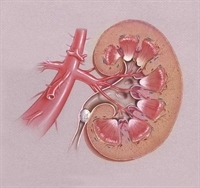| Home > 2. What is Sodium Bicarbonate Used For? > 2.6 For Kidney Stones |
 Previous Next Previous Next  |
|
|
|
Bicarbonate may be used if you have had uric acid stones.
 Substance Loss Substance LossLaxative abuse may in some cases lead to loss of basic substances with resulting metabolic acidosis, which can be corrected with the aid of oral preparations of the present invention. Dietary indiscretion of the nature described can also lead to metabolic acidosis, which can also be prevented or corrected with oral preparations of the invention. [8]
As a result, hyperchloremic acidosis is produced with excessive urinary losses of calcium, sodium, potassium, and phosphate. Nephrocalcinosis and calcium phosphate stone formation can occur as a result of hypercalciuria and low urinary citrate excretion. [9]
The loss of inhibitory or complexing activity of citrate is responsible for calcium oxalate crystallization in this group. [10]
 High Citrate High CitrateOf these, citrate is the most important. [19]
It is high in citrate, which may help prevent kidney stones. There may be symptoms of sharp pain that start in back and side, and move toward the groin or testicles. [20]
These medications can include: diuretics, phosphate solutions, allopurinol (that is used for uric acid stones), antibiotics (that are used for struvite stones), and medications that alkalinize the urine like sodium bicarbonate and sodium citrate. Bicarbonate is a baking soda and it helps in the neutralization of the acid. [21]
 Calcium Build-Up Calcium Build-UpPeople with hyperparathyroidism sometimes develop calcium stones. Treatment in these cases is usually surgery to remove the parathyroid glands, which are located in the neck. [31]
Plicamycin can also lower serum calcium levels and is especially effective against hypercalcemia secondary to certain tumors. Calcitonin may also be helpful in certain instances. [32]
Roughly four out of five kidney stones are calcium stones, usually in the form of calcium oxalate. Oxalate is found in some fruits and vegetables, but the liver produces most of the body's oxalate supply. [33]
 Acid Combinations Acid CombinationsSome antacid combinations also contain simethicone, which may relieve the symptoms of excess gas. Antacids alone or in combination with simethicone may also be used to treat the symptoms of stomach or duodenal ulcers. [61]
The study included 134 patients with advanced CKD and low bicarbonate levels (metabolic acidosis). One group received a small daily dose of sodium bicarbonate in tablet form, in addition to their usual care. [62]
Further study is required to delineate the effect of lowering uric acid on progression of gout and other renal diseases. [63]
 The Risk The RiskThe finding comes from a double-blind, randomized pilot study of 100 patients undergoing cardiac surgery and who were at high risk of postoperative AKI. Anja Haase-Fielitz, PharmaD, of Charit頕niversity Medicine, Berlin, and colleagues randomly assigned 50 subjects to receive 24 hours of IV infusion of sodium bicarbonate (4 mmol/kg) and 50 to receive sodium chloride (4 mmol/kg). [65]
You may also receive prescription medicine if you have a disease that increases your risk of forming kidney stones. Which medicine you take depends on the type of stones you have. [66]
 Medications MedicationsCall 911 for all medical emergencies. Links to other sites are provided for information only -- they do not constitute endorsements of those other sites. [68]
Medicare covers 85% of the cost. [69]
If you get more kidney stones despite drinking more fluids and making changes to your diet, your doctor may give you medicine to help dissolve your stones or to prevent new ones from forming. You may also receive prescription medicine if you have a disease that increases your risk of forming kidney stones. [70]
|
|
> >
|
|
>
> 
